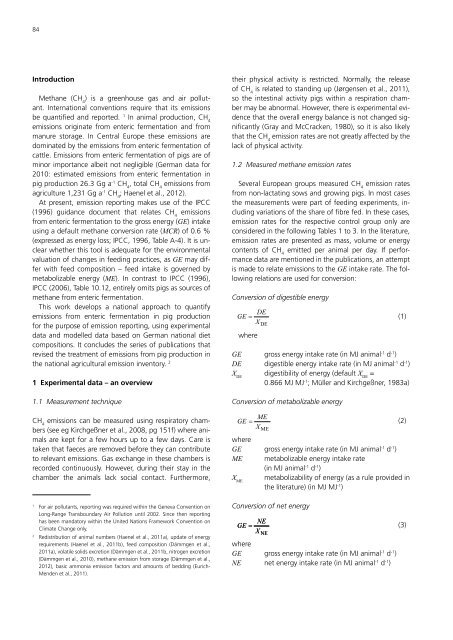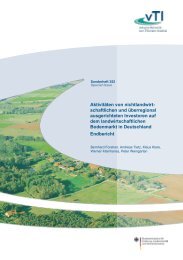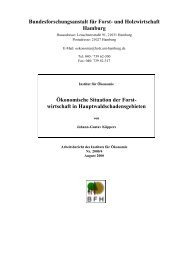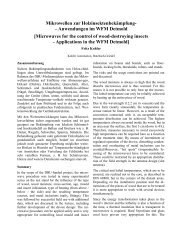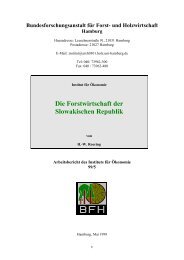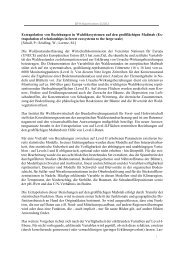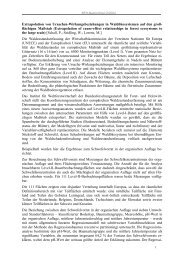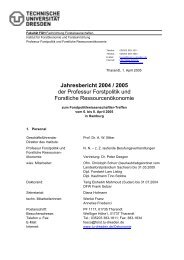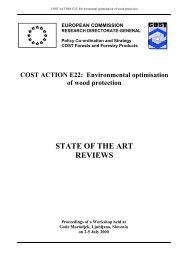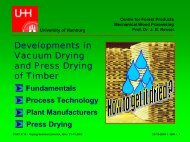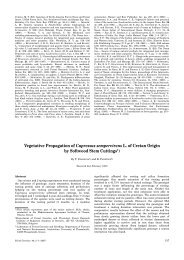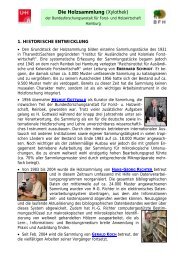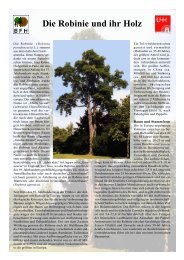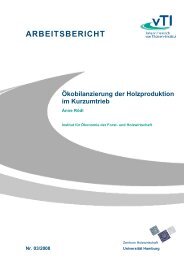Landbauforschung vTI Agriculture and Forestry ... - 1. Januar 2008
Landbauforschung vTI Agriculture and Forestry ... - 1. Januar 2008
Landbauforschung vTI Agriculture and Forestry ... - 1. Januar 2008
Create successful ePaper yourself
Turn your PDF publications into a flip-book with our unique Google optimized e-Paper software.
84<br />
Introduction<br />
Methane (CH 4 ) is a greenhouse gas <strong>and</strong> air pollutant.<br />
International conventions require that its emissions<br />
be quantified <strong>and</strong> reported. 1 In animal production, CH 4<br />
emissions originate from enteric fermentation <strong>and</strong> from<br />
manure storage. In Central Europe these emissions are<br />
dominated by the emissions from enteric fermentation of<br />
cattle. Emissions from enteric fermentation of pigs are of<br />
minor importance albeit not negligible (German data for<br />
2010: estimated emissions from enteric fermentation in<br />
pig production 26.3 Gg a -1 CH 4 , total CH 4 emissions from<br />
agriculture 1,231 Gg a -1 CH 4 ; Haenel et al., 2012).<br />
At present, emission reporting makes use of the IPCC<br />
(1996) guidance document that relates CH 4 emissions<br />
from enteric fermentation to the gross energy (GE) intake<br />
using a default methane conversion rate (MCR) of 0.6 %<br />
(expressed as energy loss; IPCC, 1996, Table A-4). It is unclear<br />
whether this tool is adequate for the environmental<br />
valuation of changes in feeding practices, as GE may differ<br />
with feed composition – feed intake is governed by<br />
metabolizable energy (ME). In contrast to IPCC (1996),<br />
IPCC (2006), Table 10.12, entirely omits pigs as sources of<br />
methane from enteric fermentation.<br />
This work develops a national approach to quantify<br />
emissions from enteric fermentation in pig production<br />
for the purpose of emission reporting, using experimental<br />
data <strong>and</strong> modelled data based on German national diet<br />
compositions. It concludes the series of publications that<br />
revised the treatment of emissions from pig production in<br />
the national agricultural emission inventory. 2<br />
1 Experimental data – an overview<br />
<strong>1.</strong>1 Measurement technique<br />
CH 4 emissions can be measured using respiratory chambers<br />
(see eg Kirchgeßner et al., <strong>2008</strong>, pg 151f) where animals<br />
are kept for a few hours up to a few days. Care is<br />
taken that faeces are removed before they can contribute<br />
to relevant emissions. Gas exchange in these chambers is<br />
recorded continuously. However, during their stay in the<br />
chamber the animals lack social contact. Furthermore,<br />
1 For air pollutants, reporting was required within the Geneva Convention on<br />
Long-Range Transboundary Air Pollution until 2002. Since then reporting<br />
has been m<strong>and</strong>atory within the United Nations Framework Convention on<br />
Climate Change only.<br />
2 Redistribution of animal numbers (Haenel et al., 2011a), update of energy<br />
requirements (Haenel et al., 2011b), feed composition (Dämmgen et al.,<br />
2011a), volatile solids excretion (Dämmgen et al., 2011b, nitrogen excretion<br />
(Dämmgen et al., 2010), methane emission from storage (Dämmgen et al.,<br />
2012), basic ammonia emission factors <strong>and</strong> amounts of bedding (Eurich-<br />
Menden et al., 2011).<br />
their physical activity is restricted. Normally, the release<br />
of CH 4 is related to st<strong>and</strong>ing up (Jørgensen et al., 2011),<br />
so the intestinal activity pigs within a respiration chamber<br />
may be abnormal. However, there is experimental evidence<br />
that the overall energy balance is not changed significantly<br />
(Gray <strong>and</strong> McCracken, 1980), so it is also likely<br />
that the CH 4 emission rates are not greatly affected by the<br />
lack of physical activity.<br />
<strong>1.</strong>2 Measured methane emission rates<br />
Several European groups measured CH 4 emission rates<br />
from non-lactating sows <strong>and</strong> growing pigs. In most cases<br />
the measurements were part of feeding experiments, including<br />
variations of the share of fibre fed. In these cases,<br />
emission rates for the respective control group only are<br />
considered in the following Tables 1 to 3. In the literature,<br />
emission rates are presented as mass, volume or energy<br />
contents of CH 4 emitted per animal per day. If performance<br />
data are mentioned in the publications, an attempt<br />
is made to relate emissions to the GE intake rate. The following<br />
relations are used for conversion:<br />
Conversion of digestible energy<br />
DE<br />
GE � (1)<br />
X DE<br />
where<br />
GE gross energy intake rate (in MJ animal -1 d -1 )<br />
DE digestible energy intake rate (in MJ animal -1 d -1 )<br />
X DE digestibility of energy (default X DE =<br />
0.866 MJ MJ -1 ; Müller <strong>and</strong> Kirchgeßner, 1983a)<br />
Conversion of metabolizable energy<br />
ME<br />
GE � (2)<br />
X ME<br />
where<br />
GE gross energy intake rate (in MJ animal -1 d -1 )<br />
ME metabolizable energy intake rate<br />
(in MJ animal -1 d -1 )<br />
X ME metabolizability of energy (as a rule provided in<br />
the literature) (in MJ MJ -1 )<br />
Conversion of net energy<br />
NE<br />
GE ��<br />
(3)<br />
X NE<br />
where<br />
GE gross energy intake rate (in MJ animal -1 d -1 )<br />
NE net energy intake rate (in MJ animal -1 d -1 )


